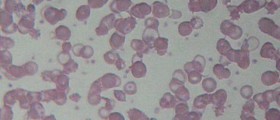
Fanconi Anemia Problems
Fanconi anemia is a genetic blood disorder, which is relatively prevalent in Ashkenazi Jews and Afrikaners affecting 1 in every 350, 000 live births. In addition, Fanconi anemia develops as a result of anomalies in proteins responsible for DNA repair. The condition is autosomal recessive, i.e. an individual needs to inherit two copies of abnormal genes, one from each parent. Those persons who have only one copy of the defected gene are the carriers of the disease, do not develop any symptoms and are rarely even aware of the fact that they carry such genes. In most instances, individuals affected by fanconi anemia develop cancer, mainly leukemia, while many also suffer from bone marrow failure. It should be noted that fanconi anemia is the most prevalent genetically inherited disease, which leads to bone marrow problems. Other health issues include physical disabilities, developmental problems with arms, head and kidneys, and endocrine system anomalies. Short stature and abnormal thumbs as well as brown birthmarks are also present in patients suffering from fanconi anemia. Life expectancy of affected individuals is relatively short. Also, the disorder is not necessarily diagnosed at birth. There have been instances in which persons have been diagnosed as late as 50 years old, and both men and women are equally prone to inheriting and developing fanconi anemia. Most people who develop the disease are diagnosed in puberty.Bone Marrow Failure
Bone marrow failure is characterized by insufficient production of all three types of blood cells, especially when it comes to red blood cells. Related problems include body’s inability to produce blood clots in order to shut the wounds and issues relating to weak immune system. In addition, patients who suffer from bone marrow failure are at an increased risk for developing all sorts of tumors such as brain, gastrointestinal, reproductive organ, liver, and blood cancers. The natural course of fanconi anemia is terminated by total bone marrow failure.Diagnosing Fanconi Anemia
Treating Bone Marrow Failure
Presently, the only way to help with the formation of blood cellular components in bone marrow failure is through hematopoietic SCT. Hematopoietic stem cell transplantation (HSCT) is a procedure in which stem cells are derived from the bone marrow or the umbilical cord. The procedure is very risky and is only performed when all other possible types of treatments fail. Most commonly seen side effects of HSCT include severe toxicities affecting the heart, gastrointestinal tract, and the skin. In addition, there have been numerous studies trying to describe the effects of HSCT, among them a longitudinal trial, which followed 50 fanconi anemia patients who received bone marrow transplants from siblings for a few years. The results revealed that 74 percent of patients lived for additional 2 and a half years following the transplant, while another 58 percent lived for 5 more years. Also, many experts agree that it is very important to perform bone marrow transplants before the onset of abnormal clonality by at least one year. When it comes to the background of HSCT, some form of the procedure has been present since the end of the 19th century, but the first realistic incidence of HSCT has been reported in 1939 when a patient received a substantial amount of marrow intravenously from his brother as a treatment for bone marrow failure. When it comes to unrelated donors for fanconi anemia, the benefits are virtually non-existent as there are too many instances of rejection and transplant related deaths. By the 1950s serious advances in transplantation procedures have been made, including the identification of the effects of chemotherapeutic agents, blood banking as well as the development of strong antibiotics. HSCT has been one of the most important medical discoveries in the latter part of the 20th century. There has been a steady increase in the number of patients who receive the transplant every year by 10 to 20 percent, and on average up to 40, 000 procedures are performed annually around the world. The main goal of HSCT is to prolong the life of the patients and it has been fairly successful in reaching that goal. Positive outcomes of the transplants are also affected by the reduction in organ damage and infection of the patients. HSCT is employed in treatment of terminally ill individuals suffering from immunideficiencies, hereditary metabolic anomalies and various types of cancer as well as bone marrow failure.
















Your thoughts on this
Loading...